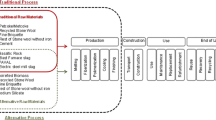Abstract
This paper appraises the utility of embodied energy as an indicator of environmental impact through the use of life cycle assessment (LCA). This utility is considered in terms of its use for the preferential selection of materials and for hotspot analysis for the purposes of identifying reduction opportunities. An appraisal of the peer-reviewed LCA of BlazeMaster® CPVC fire sprinkler system and subsequent LCA work commissioned by the Lubrizol Corporation is conducted to investigate the utility of embodied energy as an environmental indicator. Embodied energy is assessed using the Cumulative Energy Demand (CED) method and environmental impacts are appraised using the ReCiPe method. Embodied energy is found to reflect the impact results in terms of preference for CPVC when compared to steel sprinkler systems. However, the inability of CED to identify hotspots consistently, or to provide a reliable measure of relative performance for individual environmental impacts, indicates limited utility.
Access this chapter
Tax calculation will be finalised at checkout
Purchases are for personal use only
Preview
Unable to display preview. Download preview PDF.
Similar content being viewed by others
References
Aumônier, S., Collins, M., Hartlin, B., Penny, T.: Life Cycle Assessment (LCA) of BlazeMaster® Fire Sprinkler System (2010a), http://www.pvc4pipes.com/en/pdfs/BlazeMaster-LCA.pdf (accessed April 29, 2012)
Aumônier, S., Collins, M., Hartlin, B., Penny, T.: Streamlined Life Cycle Assessment (LCA) of BlazeMaster® Fire Sprinkler System in Comparison to PPR and Steel Systems (2010b), http://www.ribaproductselector.com/Docs/8/23138/external/COL436184.pdf (accessed April 29, 2012)
Goedkoop, M.: A life cycle impact assessment method which comprises harmonized category indicators at the midpoint and endpoint level, Report 1: Characterisation (January 2009), http://www.lcia-recipe.net/ (accessed April 29, 2012)
Hischier, R., et al.: Implementation of Life Cycle Impacts Assessment Methods, ecoinvent report No. 3 (July 2010)
HM Government. The Building Regulations, Approved Document B (Fire Safety), vol. 2 – Buildings other than Dwelling houses (2010)
International Standard Organisation (ISO). Environmental management Life cycle assessment Principles and framework (2nd edn, 2006-07-01). Geneva, Switzerland (2006a)
International Standard Organisation (ISO).Environmental management Life cycle assessment Requirements and guidelines (1st edn, 2006-07-01). Geneva, Switzerland (2006b)
National Assembly for Wales (NAW), Domestic Fire Safety (Wales) Measure 2011 (nawm 3). Stationery Office Limited (2011)
National Fire Protection Association, NFPA: Standard for the Installation of Sprinkler Systems, 2010 edn. (2010)
Tyco. BlazeMaster® Installation Handbook (2008), http://www.tyco-rapidresponse.com/docs/literature/blazemasterguideih_1900.pdf?sfvrsn=2 (accessed April 29, 2012)
University of Bath. Embodied Energy and Carbon in Construction Materials (2011), http://opus.bath.ac.uk/12382/ (accessed April 29, 2012)
Author information
Authors and Affiliations
Corresponding author
Editor information
Editors and Affiliations
Rights and permissions
Copyright information
© 2013 Springer-Verlag Berlin Heidelberg
About this paper
Cite this paper
Penny, T., Collins, M., Aumônier, S., Ramchurn, K., Thiele, T. (2013). Embodied Energy as an Indicator for Environmental Impacts – A Case Study for Fire Sprinkler Systems. In: Hakansson, A., Höjer, M., Howlett, R., Jain, L. (eds) Sustainability in Energy and Buildings. Smart Innovation, Systems and Technologies, vol 22. Springer, Berlin, Heidelberg. https://doi.org/10.1007/978-3-642-36645-1_52
Download citation
DOI: https://doi.org/10.1007/978-3-642-36645-1_52
Publisher Name: Springer, Berlin, Heidelberg
Print ISBN: 978-3-642-36644-4
Online ISBN: 978-3-642-36645-1
eBook Packages: EngineeringEngineering (R0)




